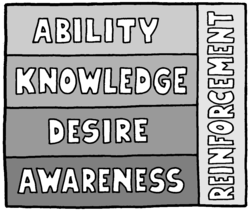No matter how big the CEO’s desk is, an organization is not a hierarchy. It…
Changing People’s Barriers
ADKAR is a great model to guide change management initiatives at the personal level.
In an earlier post I described Change Management 3.0, and it’s first part which is about Dancing with the System. Now it is time to look at change management at the individual level.
The crucial parts of a social system are the people in it. And since all people are different, there’s no one-approach-fits-all solution for change. If you need an organization to improve, you have to work with people’s individual needs, and the various barriers people put up in their minds…
Designers will find that most organizations can be considerably improved just within the context of the bounded design. This is because the barriers to change are usually in the decision-makers’ own minds and in the organization itself.– Michael C. Jackson, Systems Thinking
If you want to know how to change an organization at the level of the individual, a good place to start is the Prosci® ADKAR® Model.
The ADKAR Model
 ADKAR is a goal-oriented change management model, developed to guide activities during the change process. The model can be used to make sure you don’t forget the people aspect in your change initiative. It’s a tool that helps change agents to focus on results by making sure the change goal and the individuals in the social network are aligned.
ADKAR is a goal-oriented change management model, developed to guide activities during the change process. The model can be used to make sure you don’t forget the people aspect in your change initiative. It’s a tool that helps change agents to focus on results by making sure the change goal and the individuals in the social network are aligned.
The ADKAR model has the following dimensions:
- Awareness of the need to change
- Desire to participate and support the change
- Knowledge of how to change (and what change looks like)
- Ability to implement the change on a day-to-day basis
- Reinforcement to keep the change in place
A People’s Tool
What makes the ADKAR model so useful is that it enables you to make sure you cover multiple dimensions needed for a successful personal change of the people in an organization.
- It’s not enough for people to be aware of the need to change. They also must desire the change.
- And desire is insufficient when people have no knowledge of how to change, or when they don’t have the ability to change.
- And even if they know how, and are able to change, without any reinforcement of good behaviors people will just fall back into old habits.
When you start a change initiative in your organization, make sure to use ADKAR to address change at the individual level in all five dimensions, and lift all the barriers people have in their heads.
OK, so now I made you aware of the existence of the ADKAR model. Step 2 would be addressing your desire to click on this link to find out where I will be speaking this year. Because many of my sessions and keynotes after the summer will be about change management.
(Jurgen Appelo is author of Management 3.0, a best-selling management book for Agile developers. It has a picture of a monster in it.)
(photo: kalyan02)




